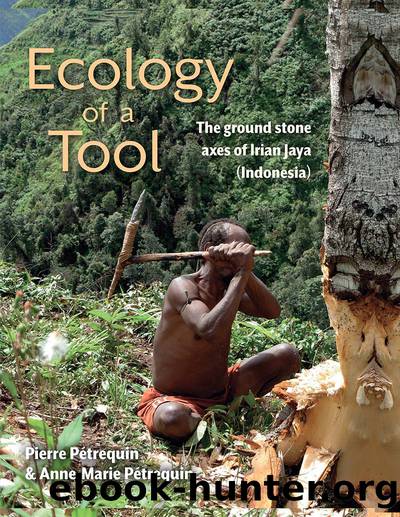Ecology of a Tool by unknow

Author:unknow
Language: eng
Format: epub
Tags: SOCIAL SCIENCE / Anthropology / General
Publisher: Oxbow Books, Limited
Published: 2020-04-29T00:00:00+00:00
In contrast, a sizeable number of the adzes made in the Heime and Mumyeme valleys reach the Eipomek Valley (Fig. 230, Eipomek, 65% of all felling tools), 70 km to the north, a 3-day walk, and Bomela, 20 km to the west, a dayâs walk. In this context in which preforms and finished blades can easily circulate, the relationships between manufacturers and users are direct. The most frequent type of exchange takes place between two related individuals or traditional exchange partners, during a visit to the Heime, the Eipomek or the Bomela. It is the only stage where an adze will travel with its manufacturer or its first exchanger. But many preforms can also change hands during the festive ceremonies, the mote, which occur episodically between two traditionally paired villages, between the valleys of the Mumyeme and the Heime in the south (Una) and the Eipomek Valley to the north (Eipo). These two areas are located on either sides of the Central Range and connected by an altitude pass at more than 3500 m. On the occasion of a mote, the whole population of a village moves, with men, women and children, to spend several days in the village of their hosts. The complementarity of the two groups is then reaffirmed by collective dances, speeches and a common meal, during which exchanges are renewed between allies â who have a kinship relationship including at least one matrimonial connection â and between exchange partners. Adze manufacturers will then offer large numbers of preforms, most often unground; in return, they will receive the products specific to the ecological niches of the north slopes, or the objects that they have deliberately chosen not to produce to facilitate exchanges with neighbouring groups: bows and arrows, bird-of-paradise feathers, nets, cassowary tibiotarsi and pigs (although eating pig meat is prohibited in the Balyo clan in Langda). These exchanges are preceded by long discussions about what to give, since giving too much would be considered an aggressive act in these exchanges based on standards of complementarity between two communities (Heeschen et al. 1980).
Figure 222. This pattern of rotang binding, with its central cross-brace and wrapping along the pointed heel, is very characteristic of the Eastern Highlands. Langda hamlet (Una group).
Download
This site does not store any files on its server. We only index and link to content provided by other sites. Please contact the content providers to delete copyright contents if any and email us, we'll remove relevant links or contents immediately.
| Anatomy | Animals |
| Bacteriology | Biochemistry |
| Bioelectricity | Bioinformatics |
| Biology | Biophysics |
| Biotechnology | Botany |
| Ecology | Genetics |
| Paleontology | Plants |
| Taxonomic Classification | Zoology |
Sapiens: A Brief History of Humankind by Yuval Noah Harari(13078)
The Tidewater Tales by John Barth(12039)
Do No Harm Stories of Life, Death and Brain Surgery by Henry Marsh(6343)
Mastermind: How to Think Like Sherlock Holmes by Maria Konnikova(6252)
The Thirst by Nesbo Jo(5795)
Why We Sleep: Unlocking the Power of Sleep and Dreams by Matthew Walker(5658)
Sapiens by Yuval Noah Harari(4553)
Life 3.0: Being Human in the Age of Artificial Intelligence by Tegmark Max(4521)
The Longevity Diet by Valter Longo(4454)
The Rules Do Not Apply by Ariel Levy(3915)
The Immortal Life of Henrietta Lacks by Rebecca Skloot(3833)
The Body: A Guide for Occupants by Bill Bryson(3817)
Why We Sleep by Matthew Walker(3782)
Animal Frequency by Melissa Alvarez(3762)
Yoga Anatomy by Kaminoff Leslie(3712)
Barron's AP Biology by Goldberg M.S. Deborah T(3636)
The Hacking of the American Mind by Robert H. Lustig(3588)
All Creatures Great and Small by James Herriot(3527)
Yoga Anatomy by Leslie Kaminoff & Amy Matthews(3405)
